Prepare your taste buds for a fruity journey today as we discover the fruits that start with the letter T! From tropical sensations to tangy surprises, this article is your gateway to a delectable assortment of nature’s treasures.
Beyond their delicious flavors, these fruits offer a wealth of nutrients that contribute to a wholesome diet. So, let’s get to know the 15+ let’s start this flavorful journey to uncover some of the most tempting “T” fruits that might soon find a place on your plate!
1. Tiger Stripe Figs

An interesting type of fruit that starts with the letter T is the
tiger
stripe fig.
©Pepe77/Shutterstock.com
Tiger stripe figs are a special kind of fig, recognized by their distinct, patterned skins. Widely known for their exceptional taste, they boast a complex flavor profile that is a treat for many.
Also known as panache figs, these fruits have yellow and green streaks, marking their ripe exterior. When split open, they reveal an interior pulp ranging in color from a rich pink to a dark burgundy. The taste of tiger stripe figs is sweet and zesty, almost like raspberry jam.
While the origins of tiger stripe figs remain somewhat unknown, some researchers associate them with ancient fig varieties from countries like France, Italy, or Spain. References to this fig variety can be found in historical documents spanning the 17th to the 19th centuries. Eventually, this fig found a perfect environment in the warm regions of California in the USA, where it thrives to this day.
2. Tayberry

Surprisingly, tayberries are quite large, around 2 inches long!
©M. Schuppich/Shutterstock.com
A tayberry looks just like you might expect from a fruit hybrid, blending the pink color of a raspberry with the deep black of a blackberry to create a rich, purple fruit. These berries are quite large, around 2 inches or 5 centimeters long!
When it comes to taste, tayberries resemble raspberries but are sweeter. They lack the tartness of their red counterparts, making them a delightful choice for snacking without the need for added sugar or cream.
These berries trace their origins to Scotland and get their name from the Tay River in Scotland, where they were developed.
3. Tomatillo
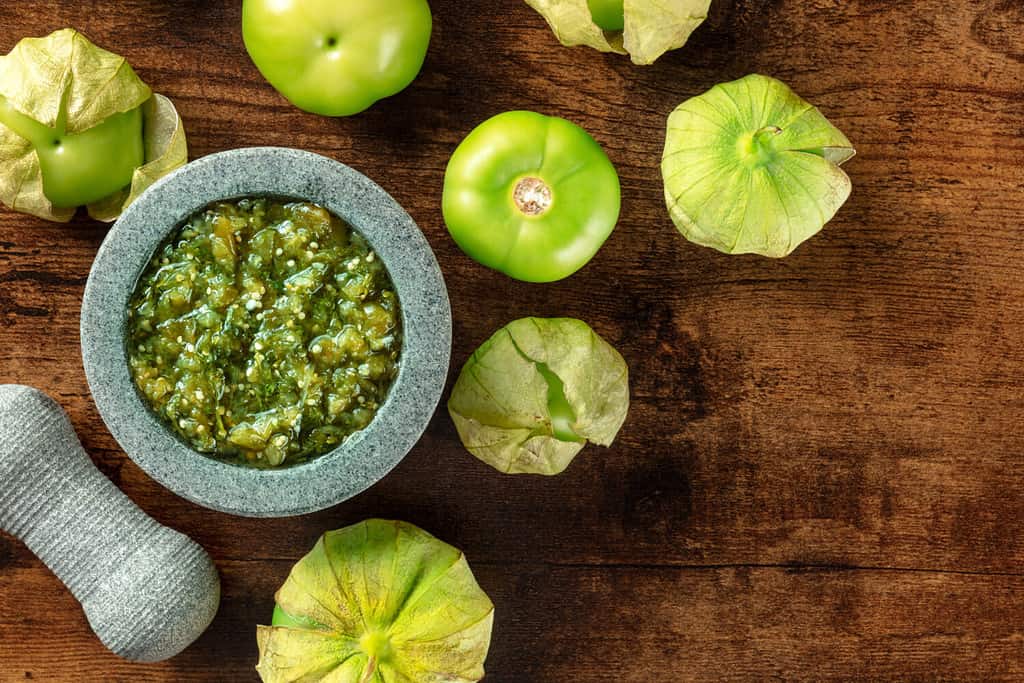
Another fruit that starts with T is the tomatillo, which looks like a small, green tomato.
©Plateresca/Shutterstock.com
A tomatillo is a small, green, round fruit that resembles a tiny tomato. Fresh tomatillos offer a distinct flavor profile, featuring a tangy, vibrant, and almost citrus-like taste. Typically, they are enjoyed cooked, but you can also have them raw. Interestingly, when tomatillos are boiled, they keep their tangy flavor. Roasting tomatillos transforms them, however, making them a bit sweeter and milder while reducing their natural tanginess.
These green fruits have their roots in Mexico and Central America, where they’ve been a crucial food source for many generations.
4. Torpedo Melon

Torpedo melons have yellow skin with white stripes and come from Uzbekistan.
©Sergey Fatin/Shutterstock.com
These melons are small, with yellow skin and white stripes. Torpedo melons are often considered “personal-sized” since they are smaller in comparison to other varieties. You can eat both the flesh and the skin of these melons, and they are packed with nutrients, containing as much as 85% water content.
When it comes to taste, torpedo melons share similarities with a mix of honeydew and cucumber. These fruits are refreshingly light and crisp, offering a subtle sweetness that won’t overpower your taste buds like cantaloupe can. Additionally, they have a decent ability to resist powdery mildew, which makes them thrive in humid spring and fall seasons.
These melons hail from Uzbekistan and Central Asia and were later introduced to California.
5. Thimbleberry
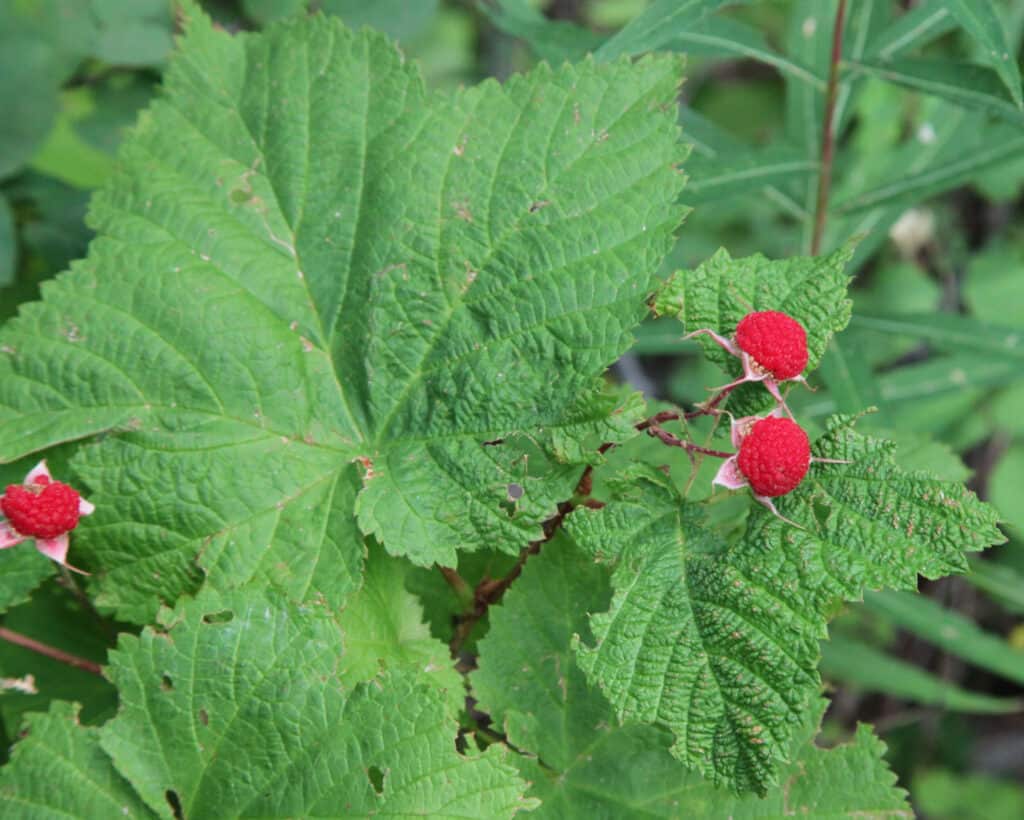
Native to North America, thimbleberries are another fruit that starts with the letter T.
©Nikki Yancey/Shutterstock.com
Thimbleberries are small fruits, typically measuring between 0.4 to 0.8 inches (or around 1 centimeter) in size. They have a curved, flattened appearance, almost like raspberries but flatter. These fruits are made up of tiny, juicy drupelets that contain numerous small, crunchy seeds.
Their outer layer is extremely smooth and has a slight fuzz to it. The color of these berries changes as they mature, starting as white, transitioning to pink, and eventually becoming red. Thimbleberries have a nice scent and a flavor that combines sweetness with a hint of tartness, followed by a fruity note.
In certain areas of the Upper Peninsula in Michigan, making jam from thimbleberries has become a beloved practice, especially in regions like Keweenaw and Houghton counties.
This berry is native to a large section of the western part of North America. Separate patches of these plants are also found on the eastern side of the Black Hills in South Dakota and even in the Great Lakes area.
6. Topaz Apple
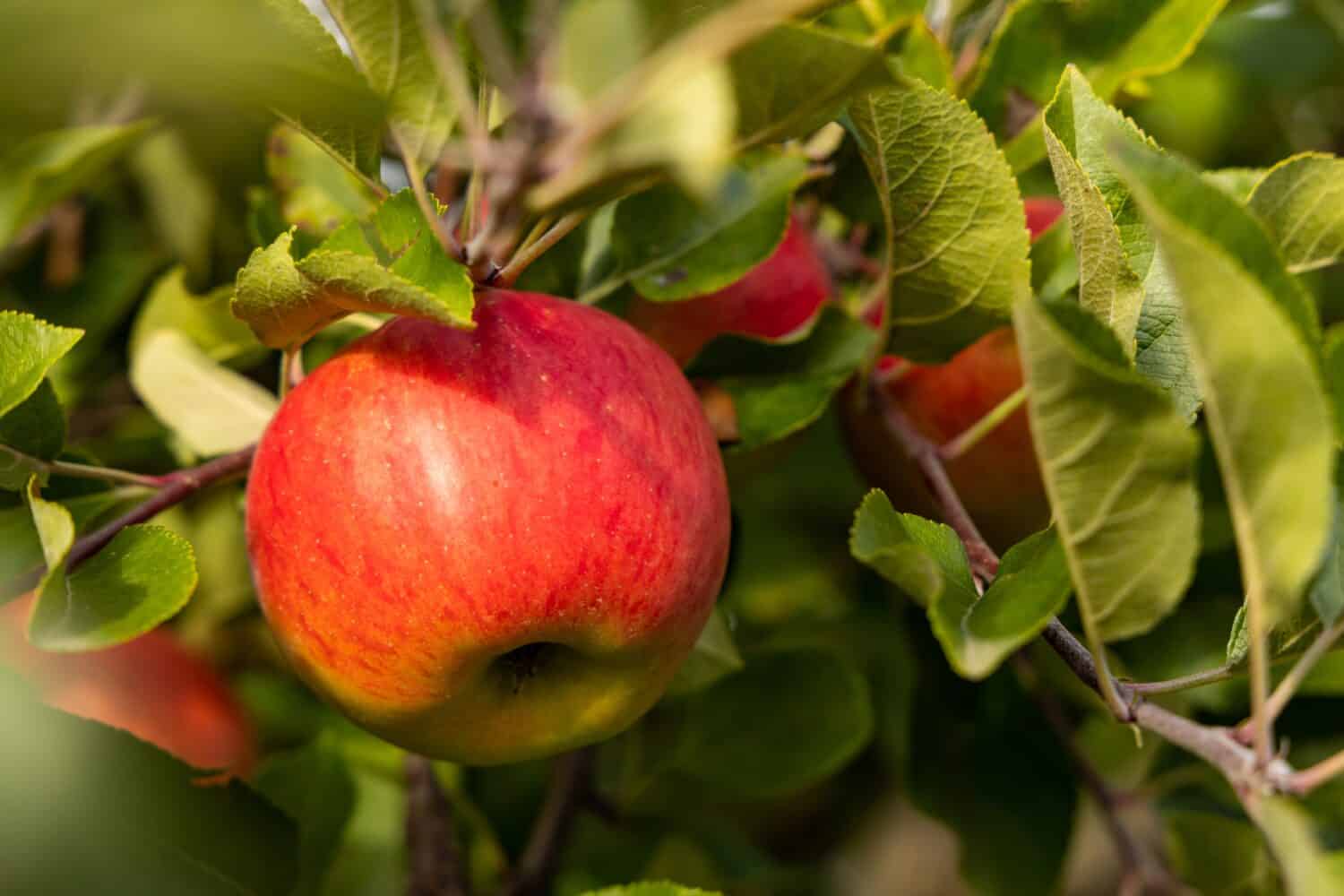
Originating from the Czech Republic, the topaz apple is a delicious fruit that starts with T.
©AlexBuess/Shutterstock.com
The topaz apple is a medium-sized fruit created by crossing the “Rubin” and “Vanda” apple varieties. It’s not too big, with a flattened, somewhat round shape featuring curved edges and a flat bottom and top. The apple’s skin is fairly thin, has a slight shine, and shows some ridges along with a few tan spots on the surface.
When you encounter topaz apples, you’ll notice a gentle, sweet, floral, and slightly earthy scent. Initially, they have a sharp taste that becomes milder as they ripen. These freshly picked apples offer a delightful combination of sweetness and tartness, with hints of robust spice, acidity, and sugary notes.
This apple variety hails from the Czech Republic and is known for its resistance to modern apple diseases.
7. Texas Persimmon
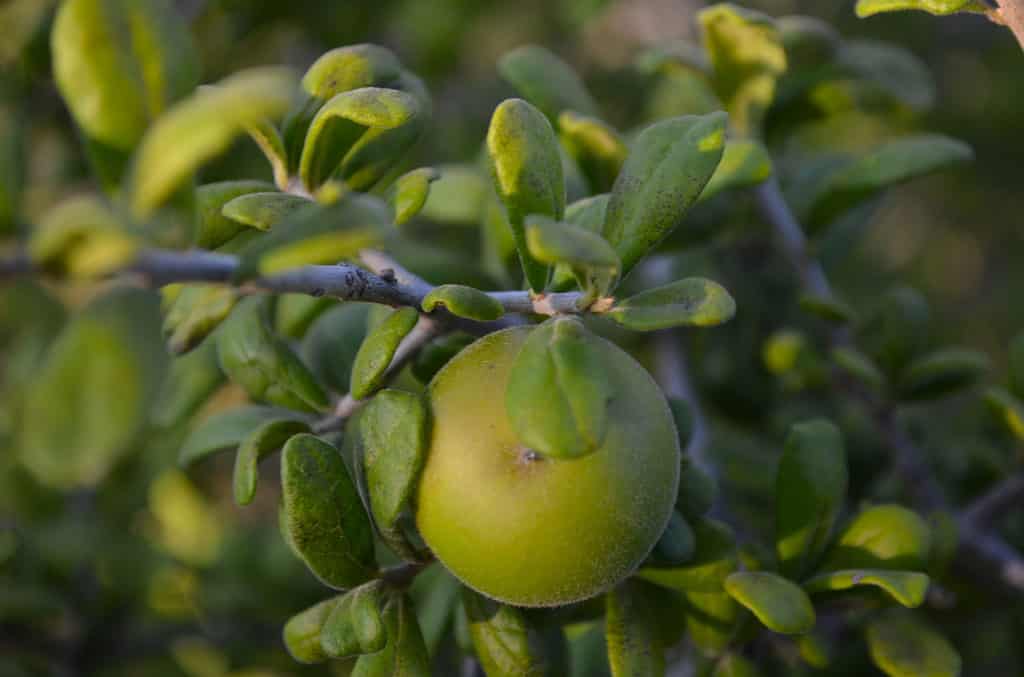
When ripe, the Texas persimmon will turn black and sweet.
©Renee Foskett/Shutterstock.com
The Texas persimmon is a type of persimmon fruit – although it may not look like it! It’s a round, fleshy fruit, about 1 inch in size, and turns black and sweet when it’s fully ripe. This usually happens from late July to September.
To enjoy these fruits, it’s best to wait until they become very soft and squishy while still on the plant. Their flavor is a bit like a mix of a blackberry and a fig; some people even liken it to prunes.
This fruit is originally from central, southern, and western Texas, as you might be able to guess from its name. The Texas persimmon is also found in southwestern Oklahoma.
8. Tropical Apricot
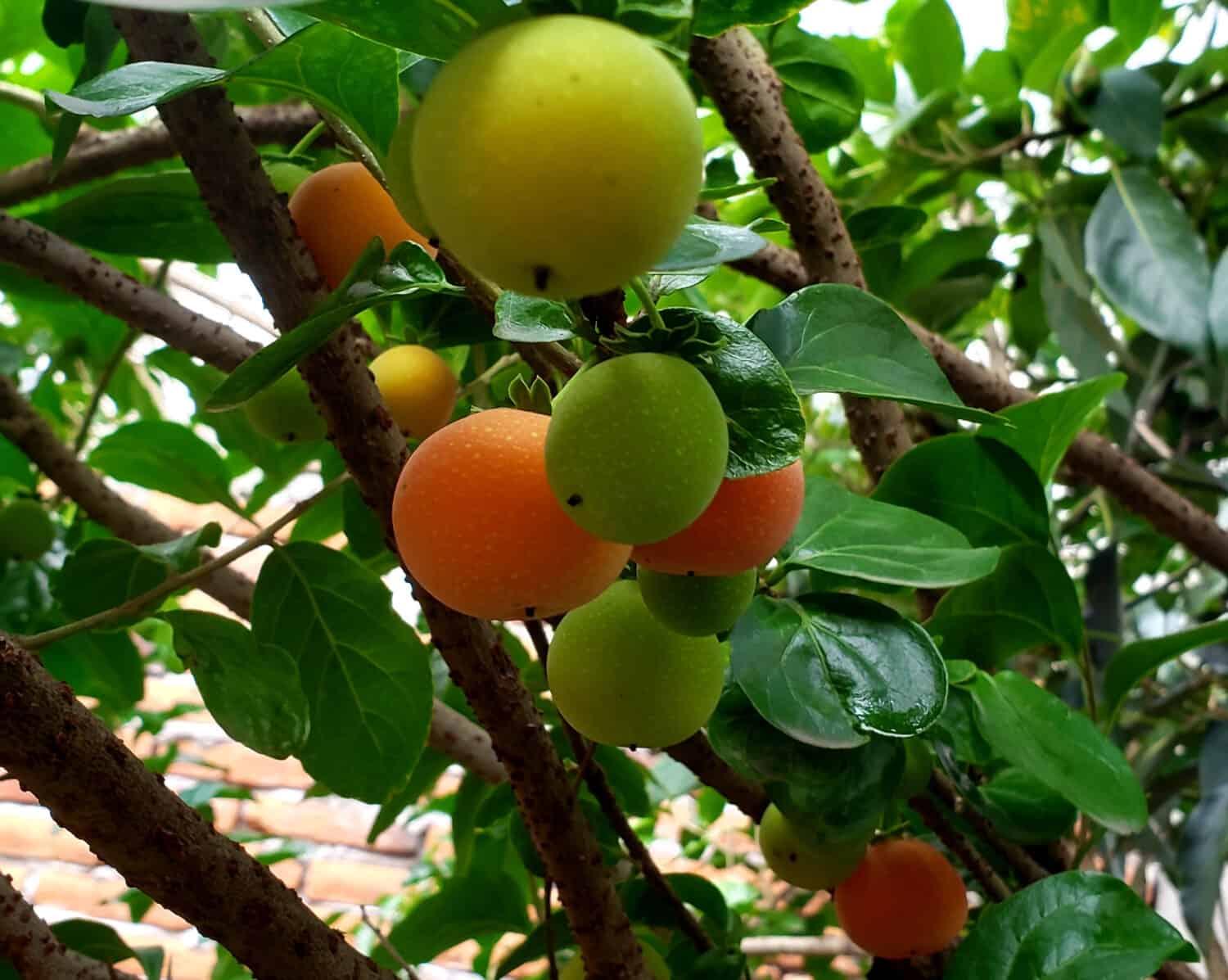
When ripe, the tropical apricot turns from a green color to yellow-orange or red.
©robert gibson z/Shutterstock.com
The tropical apricot is a fruit with a thin skin ranging from three-quarters of an inch to nearly 2 inches in diameter. It changes color from green to a pale yellow-orange, and when fully ripe, it can even turn red. Inside, the flesh is soft and yellow-orange.
Tropical apricots have a flavor reminiscent of regular apricots but are notably sour and astringent. People often cook them with an equal amount of sugar to balance out the acidity.
These fruits are originally from Africa, while a hybrid variety is native to Florida.
9. Tompkins King Apple
The Tompkins king apple is a sizable fruit with smooth, yellow skin that often has an orange-red blush on its yellow backdrop. Although the coloring can vary among apples, even on the same tree, most King apples are quite attractive and generously sized.
These apples are versatile and can be enjoyed fresh, used for making cider, or added to various dishes. Inside, the flesh of a Tompkins king apple is yellowish, coarse, crisp, and smells delicious. As for the taste, it is slightly tangy.
This apple is believed to have originated in New Jersey but gained popularity thanks to Jacob Wycoff, a grower in Tompkins County, New York, who introduced it around 1805.
10. Tamarind
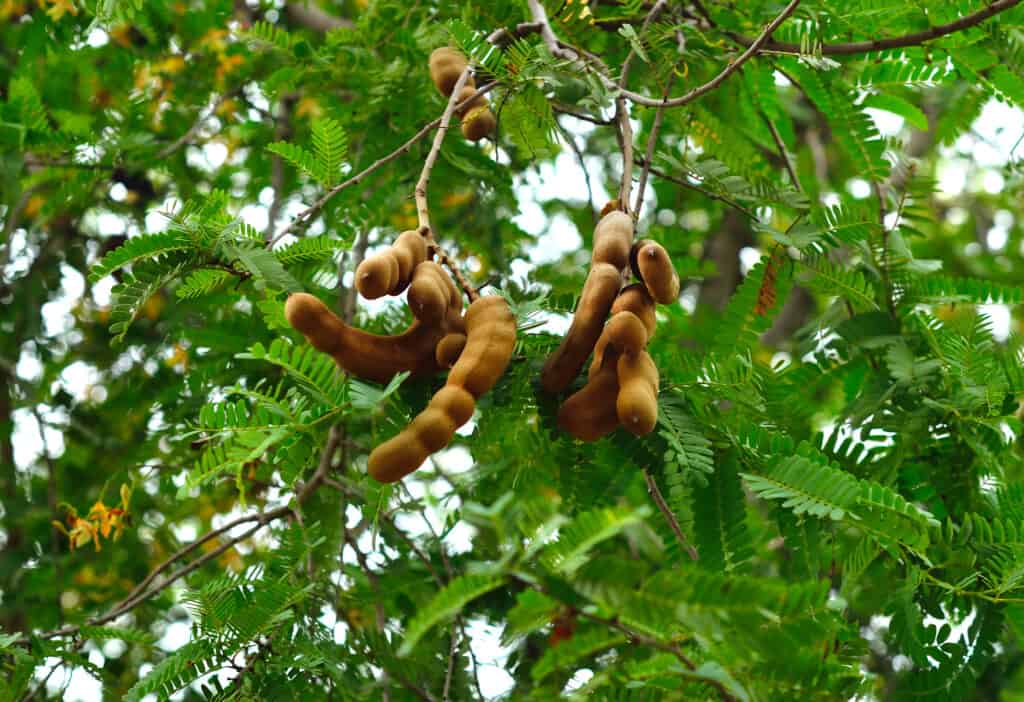
This tropical fruit that starts with T is tamarind.
©iStock.com/mypuy
Tamarind is a tropical fruit that comes from the tamarind tree. It has a tough outer shell that resembles a long peanut shell or a brown edamame (soybean) pod. Inside, you’ll find a fleshy pulp with a texture similar to dates.
Tamarind has a unique sweet and sour taste that people love in both sweet and savory dishes. Its flavor has been likened to a zesty blend of lemon or lime with sweet caramel hints or a combination of apricot, lemon, and dates.
Tamarind trees are originally from Africa but can also be found in other tropical areas.
11. Tomato
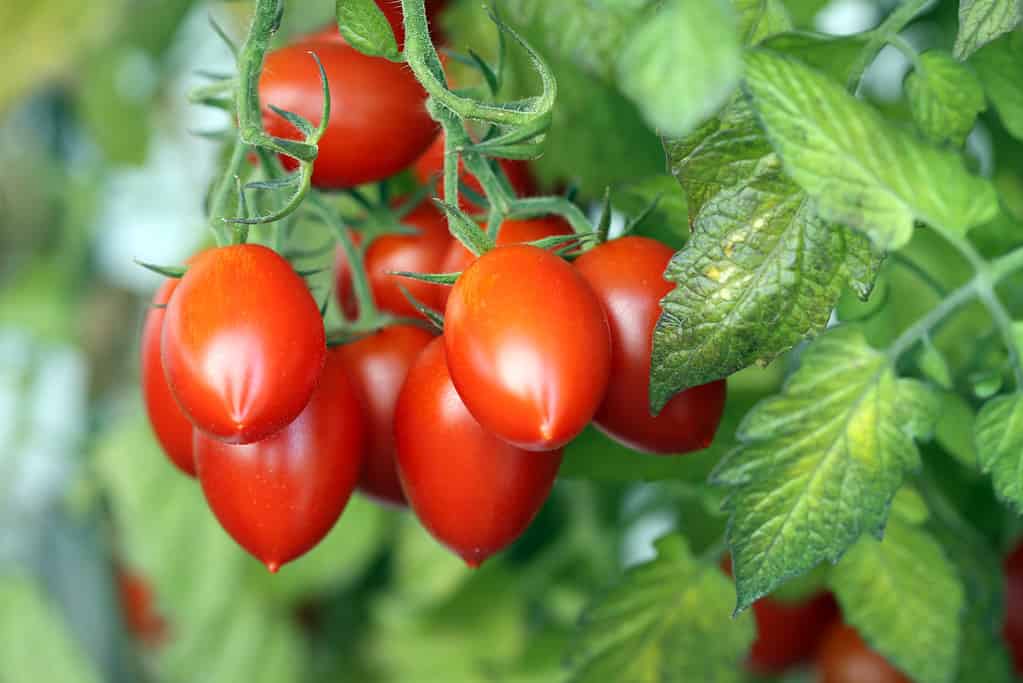
Of course, one of the most famous fruits that start with T is the tomato.
©Bernhard Richter/iStock via Getty Images
The tomato is a type of fruit found on the tomato plant, scientifically known as Solanum lycopersicum. You can find them in red, yellow, or even scarlet colors. There are also green and purple kinds available. The shapes of tomatoes can vary quite a bit, from being nearly round to more oval or elongated shapes, and even resembling a pear in some cases. Inside, you’ll usually find at least a couple of sections filled with seeds encased in a somewhat gooey pulp.
Tomato is a blend of sweet and slightly sour flavors. However, it is possible to come across tomatoes with a more subdued flavor profile. These fruits can be fried up, eaten raw, or boiled! There are no limits to what you can do with the tomato!
Tomatoes first appeared in South America, particularly in the region of the Andes mountains. In Mexico, these fruits have been cultivated as a regular crop since 500 BC.
12. Tamarillo
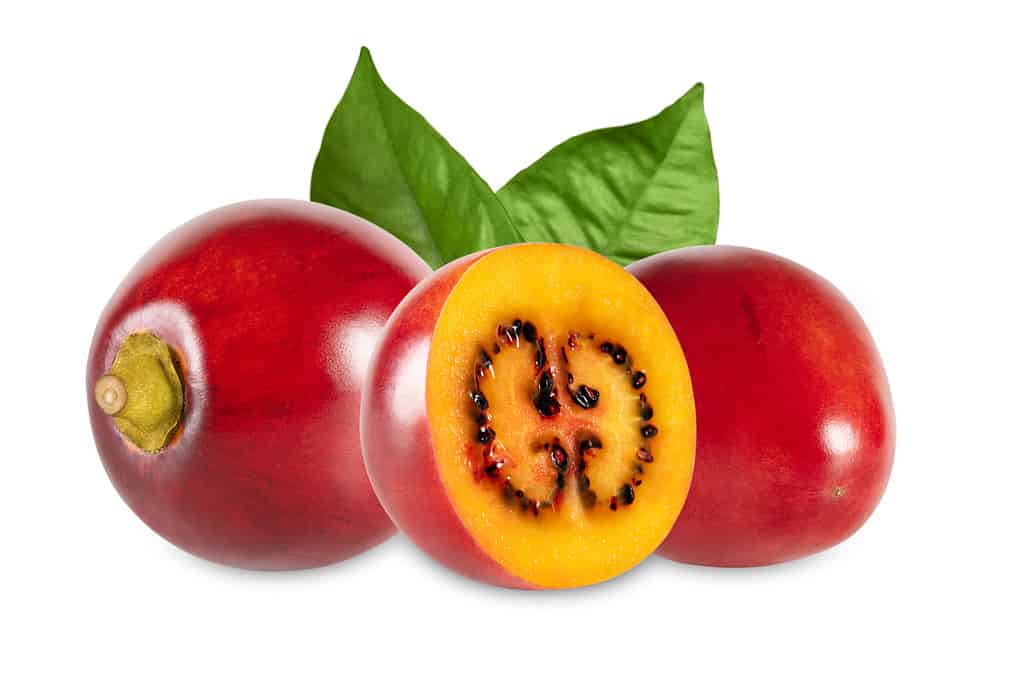
Also called the tree tomato, the tamarillo originates from the Andes.
©Marina Bagrova/iStock via Getty Images
Tamarillos are little fruits that are about as big as a duck egg. These fruits grow on trees in places where the weather is mostly warm. They kind of look like tomatoes due to their red coloring and oval form, generally measuring between 2 to 4 inches in length. These fruits usually grow on elongated stems, sometimes grouped together. The fruit’s skin is sleek and shines with purple, red, or pale yellow colors.
Its flavor has a touch of sweetness. Many individuals mention that its flavor brings to mind a blend of various fruits such as kiwifruit, tomato, guava, or passion fruit. It’s worth noting that the skin and the area near it can have a slightly bitter flavor, which is why it’s usually not consumed raw.
These fruits are originally from regions in the Andes, covering countries like Argentina, Colombia, Ecuador, Chile, Peru, and Bolivia.
Even now, people in these areas grow tamarillos in their home gardens or on small fruit farms, making it a favorite fruit for many locals. Interestingly, the original name of the tamarillo is the tree tomato.
13. Tangerine

Another popular fruit that starts with T is the tangerine.
©Svetlana Serebryakova/Shutterstock.com
Tangerines are a type of citrus fruit, similar to mandarins in many ways. When they’re ripe, they have a slightly soft feel and pebbly, orange skin without deep grooves. The peel is thin, with very little bitter white inner layer.
The tangerine’s taste can be likened to oranges, but they pack more flavor. They are sweeter and lack the same level of tanginess that you find in oranges, making them easier to eat and enjoy.
These fruits are believed to have originated in Southeast Asia. Their name comes from the fact that they were often shipped through the port of Tangier in Morocco.
14. Tommy Atkins Mango
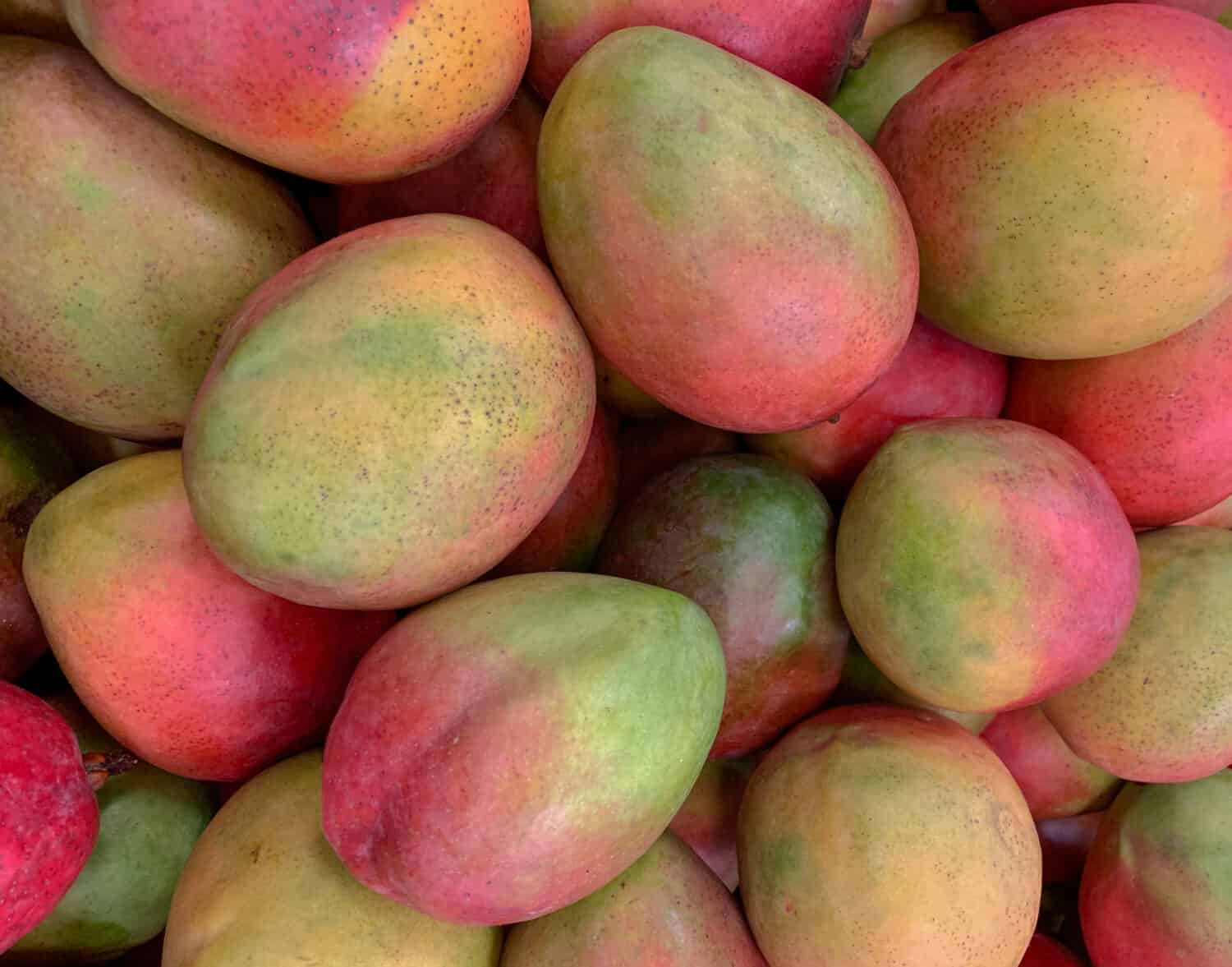
Weighing up to two pounds, Tommy Atkins mangoes are super popular in Florida.
©Rosamar/Shutterstock.com
Tommy Atkins mangoes are medium to large-sized mangoes and can weigh up to two pounds. Like many other types of mangoes, these mangoes are oval-shaped and have green skin covered with a red blush. They will also have orange or yellow accents as well. While the skin itself feels smooth, it may be covered in pores. In terms of taste, Tommy Atkins mangoes are incredibly juicy and slightly sweet.
First discovered in Florida in the 1920s, Tommy Atkins mangoes weren’t commercially available until the 50s! Now, this is one of the most popular varieties in Florida. These mangoes are also grown in Mexico, Ecuador, Hawaii, and Brazil.
15. Taylor’s Gold Pear

Taylor’s gold pear is a New Zealand variety of pear.
©David Pimborough/Shutterstock.com
Looking very similar to a comice pear, Taylor’s gold pears are medium to large with a round base that tapers to a smaller curved neck. This fruit also has a dark brown stem. This pear’s skin is smooth and beige or cinnamon in color with the occasional rose blush. The delicious ivory-colored flesh is moist but firm with a creamy and juicy texture. This delicious pear is rich and sweet, with some individuals picking up on mild honey notes.
First discovered in New Zealand in 1986, Taylor’s gold pears may be a mutation of a comice pear or a cross between a comice and a bosc pear.
Comprehensive List of All Fruits that Start with T
- Tiger Stripe Figs
- Tayberry
- Tomatillo
- Torpedo Melon
- Thimbleberry
- Topaz Apple
- Texas Persimmon
- Tropical Apricot
- Tompkins King Apple
- Tamarind
- Tomato
- Tamarillo
- Tangerine
- Tommy Atkins Mango
- Taylor’s Gold Pear
- Tachibana Orange
- Tarap (Terap)
- Totapuri Mango
- Tangelo
- Tasmania Tiger Fuji Apple
- Tart Cherry
- Teardrop Tomato
- Tristar Strawberry
- Triamble Pumpkin
Summary of Fruits That Start With T
| Number | Fruit | Benefits |
|---|---|---|
| 1. | Tiger Stripe Figs | Vitamins A and K, magnesium, potassium, and fiber |
| 2. | Tayberry | Vitamins K and C, folate, folic acid, and fiber |
| 3. | Tomatillo | Vitamins A, E, and C, potassium, and fiber |
| 4. | Torpedo Melon | Vitamins C, A, B1, and B2, chlorine, potassium, iron, and calcium |
| 5. | Thimbleberry | Vitamins A and C, calcium, iron, and potassium |
| 6. | Topaz Apple | Vitamins A, E, C, and K, magnesium, iron, and copper |
| 7. | Texas Persimmon | Vitamins A and C, potassium, and fiber |
| 8. | Tropical Apricot | Vitamins A, B, and C, iron, fiber, and phosphorus |
| 9. | Tompkins King Apple | Vitamin C and fiber |
| 10. | Tamarind | Vitamins B and C, magnesium, potassium, and antioxidants |
| 11. | Tomato | Vitamin C, potassium, folate, fiber, and antioxidants |
| 12. | Tamarillo | Vitamins A, E, and C, iron, fiber, and protein |
| 13. | Tangerine | Vitamins C and A, potassium, and folate |
| 14. | Tommy Atkins Mango | Vitamins C, A, and B6, fiber, potassium, calcium, and iron |
| 15. | Taylor’s Gold Pear | Vitamin C, potassium, antioxidants, fiber, and calcium |
The photo featured at the top of this post is © Rosamar/Shutterstock.com
Thank you for reading! Have some feedback for us? Contact the AZ Animals editorial team.







